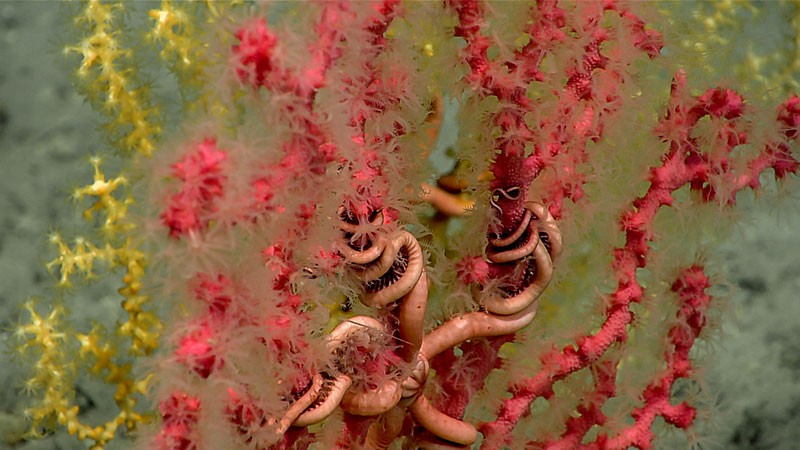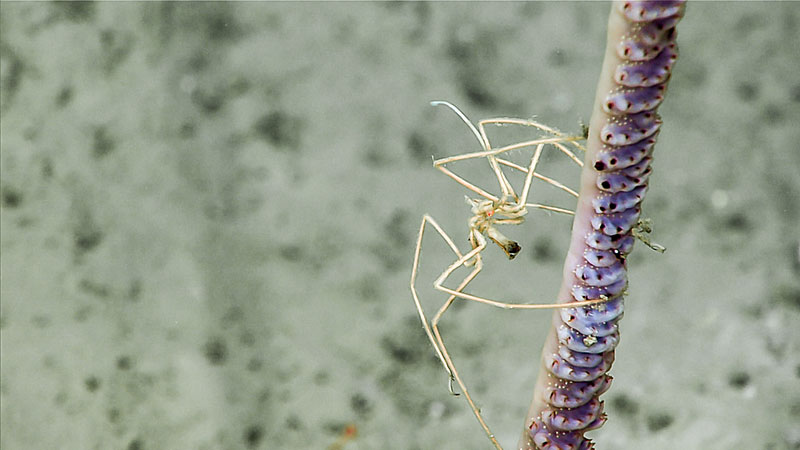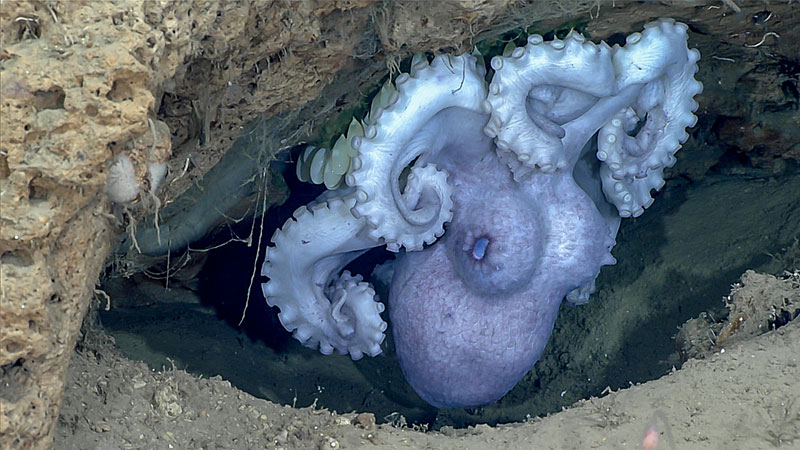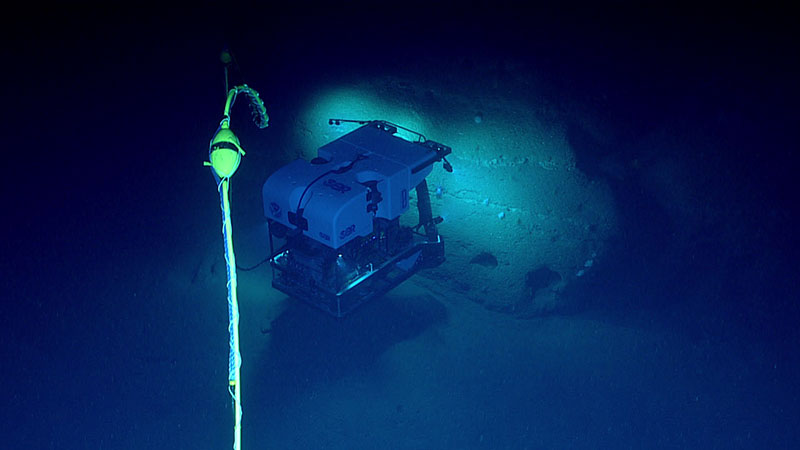
Date: July 9, 2019
Location: Lat: 38.3169°, Lon: -74.4284°
Dive Depth Range: 1,395 - 1,533 meters ( 4,993 - 5,030 feet)
Access Dive Summary and ROV Data
A brooding warty octopus guards her eggs. An octopus of the same genus, but along the Pacific coast, was found to guard eggs for upwards of four years, suggesting that this devoted mother could be protecting her eggs, without leaving even for food, for a very long time. Video courtesy of the NOAA Office of Ocean Exploration and Research, Windows to the Deep 2019. Download larger version (mp4, 90.8 MB).
Today we dove along the south facing wall in Wilmington Canyon. Wilmington Canyon is one of the major mid-Atlantic canyons that remains relatively unexplored. The remotely operated vehicles (ROVs) reached the bottom in the trough of the canyon around 1,533 meters (5,030 feet). This area was sedimented and had a high abundance of very small (about one centimeter) swimming holothurians, pancake urchins, a few large pycnogonid sea spiders, a number of different sea pens, the proboscis of a few spoon worms extended out of seafloor holes, and a number of different types of fish including Synaphobranchus eels, deep-sea lizardfish, juvenile cusk eels sheltering in the spines of urchins, and a halosaur (Halosauropsis macrochir).

This octocoral and brittle star associate was documented on the rocky substrate during Dive 17 of Windows to the Deep 2019. Image courtesy of the NOAA Office of Ocean Exploration and Research, Windows to the Deep 2019. Download larger version (jpg, 1.4 MB).
As we encountered the hard rock substrate around 1,494 meters (4,902 feet) we started to observe brisingid sea stars; octocorals; giant solitary hydroids (Monocaulus sp.); and two species of octopods – warty octopods (Graneledone verrucosa) and a Muusoctopus johnsonianus, including the first of what would become many sightings of a warty octopus under a rock ledge in a poster guarding her eggs that were attached onto the rock surface. As the dive progressed, we observed over 20 individuals of warty octopods in a brooding poster in crevices and small cave-like areas in the rock surface. At least half of the octopods had eggs that were visible and the others could have had eggs hidden by their arms. Various color variations were observed across the individual brooding octopods and it was suggested to be due to various levels of senescence, or gradual deterioration, since the mother likely stays and guards the eggs until they hatch. A similar species of warty octopod has been observed in the Pacific in the same brooding poster over a four-year period.

This image of a sea pen and pycnogonid sea spider was taken during Dive 17 of Windows to the Deep 2019. The sea spider’s proboscis is retracted, indicating that it was not currently feeding on the sea pen. Image courtesy of the NOAA Office of Ocean Exploration and Research, Windows to the Deep 2019. Download larger version (jpg, 967 KB).

Many warty octopus individuals were seen in brooding posters in crevices and small cave-like areas in the rock surface during Dive 17 of the Windows to the Deep 2019 expedition. The eggs of the octopus can be seen to the left of its arm, hanging from the ceiling of the crevice. Image courtesy of the NOAA Office of Ocean Exploration and Research, Windows to the Deep 2019. Download larger version (jpg, 1.5 MB).
This dive had very interesting geology with the rock features having imbedded fossilized fluid burrows whose formation is unknown. In the rubble/sedimented area around the rocks, we observed a number of corals, including octocorals and cup corals and various species of sea pens. We collected two octocoral and a black coral during the dive, with it ending around 1,395 meters (4,577 feet).

The remotely operated vehicle Deep Discoverer scaling Wilmington Canyon during Dive 17 of the Windows to the Deep 2019 expedition. Image courtesy of the NOAA Office of Ocean Exploration and Research, Windows to the Deep 2019. Download larger version (jpg, 530 KB).

Location of Dive 17 on July 9, 2019. Download larger version (jpg, 2.3 MB).

The remotely operated vehicle track for Dive 17, shown as an orange line with a white curtain. Scale is water depth in meters. Download larger version (jpg, 1.9 MB).